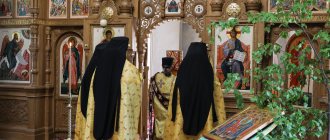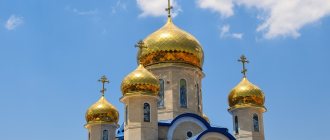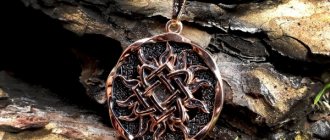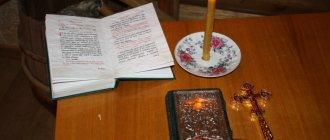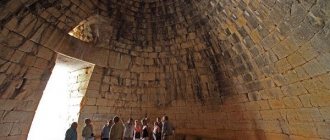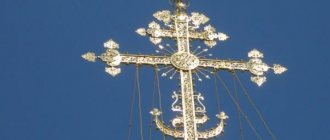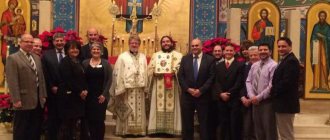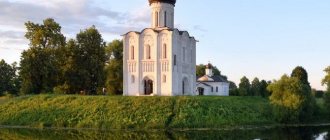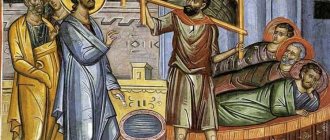Colors of vestments and explanations for them
Home » Knowledge base » Concepts and terms » Colors of vestments and explanations for them
by Administrator · 11/19/2019
| White color | ||
| Symbol of Divine uncreated light. Combines all the colors of the rainbow | They serve in white vestments on the Lord's holidays: the Nativity of Christ, Epiphany, Ascension, Transfiguration; They serve on Lazarus and Great Saturday, days of remembrance of the ethereal Angelic forces, and Easter Matins begins in them. White vestments are used during the sacrament of baptism, weddings and funeral services, as well as when vesting a newly ordained person in the priesthood. | |
| Red color | ||
| This is a symbol of God’s inexpressible, fiery love for the human race. But it is also the color of blood, and therefore services in honor of martyrs are held in red or scarlet vestments | The main Easter color is red and gold. Following the white one, the Easter service continues and remains unchanged until the Feast of the Ascension. The red color of vestments is also adopted on days of remembrance of martyrs. | |
| Golden color or yellow of all shades | ||
| Are the colors of glory, greatness and dignity | They have adopted Sundays as the days of the Lord, the King of Glory; in addition, in golden robes the Church celebrates the days of His special anointed ones - prophets, apostles and saints; also on most days of the year, unless someone's memorial is being celebrated. | |
| Green color | ||
| Color of eternal life | A fusion of yellow and blue. It was adopted on the days of remembrance of the saints and testifies that their monastic feat revives a person through union with Christ (yellow) and elevates him to heaven (blue). Green flowers of all shades are used on the day of the Holy Trinity, the Entry of the Lord into Jerusalem (Palm Sunday), Monday of the Holy Spirit, as well as on the days of holy fools. | |
| Blue or blue color | ||
| This is the color of the sky, and it corresponds to the teaching about the Mother of God, who contained the Celestial Being in Her Most Pure Womb | Color for the feasts of the Blessed Virgin Mary, as well as for Candlemas. | |
| Purple | ||
| It combines red - the color of the blood of Christ and the Resurrection, and blue, indicating that the Cross opened the way to heaven for us. Signifies the strength of spirit and the feat of the cross of the Savior | Adopted in the days of remembrance of the Cross of the Lord - the Origin (wearing down) of the venerable trees of the Life-giving Cross of the Lord, the Exaltation, in the Cross-Worshiping Week of Great Lent (Middle Cross). On Saturdays and Sundays of Lent, Maundy Thursday. On the First and Second Finding of the Head of John the Baptist and on the day of the Forty Martyrs of Sebaste. | |
| Black or dark brown color | ||
| Closest in spirit to the days of Great Lent. This is a symbol of renunciation of worldly vanity, the color of crying and repentance | Used on ordinary days of Lent. Black vestments officially appeared in Russia only in 1730, and then only for funeral services (it is interesting that later white vestments “won” at funeral services, and black ones “went away” during Lent from the end of the 19th century). The liturgical regulations do not recognize the color black, and during Lent and Holy Week it is necessary to serve not in mourning, but in dark robes of crimson or violet. | |
Colors of liturgical vestments in Orthodox funeral services.
Any attentive person who visits an Orthodox church during a service will notice that on different days of the year the vestments of the clergy and the church decorations change in color. Vestments of almost all colors of the rainbow are used, as well as white and black. This diversity is an integral part of liturgical symbolism and is intended to have a certain impact on the minds and feelings of those praying. In this short article we will not talk in detail about the symbolism of each of the colors used, but will focus only on those that are adopted in the Orthodox funeral rite. After all, the color of the vestment changes not only depending on the event celebrated by the Church, but also on the nature of the service. To perform rites of remembrance of the dead, as well as divine services on parental Saturdays, the church charter prescribes the use of white vestments. It is this color that most fully corresponds to the content of funeral prayers, in which for those who have departed to another world, repose is requested with the holy righteous, who, according to the Revelation of the Apostle John the Theologian, are dressed in white vestments (Rev. 7, 9). The Bible also says that the angels who appeared after the Resurrection of Christ were dressed in white robes (Mark 16:5). The white color, which combines all the colors of the rainbow, symbolizes the Divine uncreated light. Evangelist Mark, describing the event of the Transfiguration of the Lord, says that “His clothes became shining, very white, like snow” (Mark 9:3). It is known that snow gives rainbow tints when the sun shines brightly. A rainbow is white light spread out in a spectrum; in the biblical narrative it was a symbol of God’s Covenant with humanity after the Flood. Almost all other colors of the rainbow are also used in Orthodox worship, revealing various aspects of Sacred history and spiritual life. Thus, it is white that can be considered the main symbolic color of the Church. This color is not only used in funeral services. Priests wear light vestments when performing all the sacraments of the Church, as well as on most of the Lord's holidays (dedicated to the events of the earthly life of Jesus Christ). On Easter, the service also begins in white robes, symbolizing the light of life shining from the Savior’s tomb, then changes into red robes. This color marks the triumph of God’s fiery love for the human race, revealed in the redemptive feat of the Son of God, through the shedding of the Lord’s blood on the Cross. On Bright Week (seven days of Easter celebrations), funeral services are performed according to a special Easter rite. Essentially these are Easter chants, to which are added separate funeral petitions. This is a joyful ritual in which there is no place for crying and sobbing, everything is imbued with Easter celebration. To die on Easter and to be inveterate in such a manner is revered by the Orthodox as a sign of God’s special mercy to man. Of course, the funeral service held these days is also performed in red Easter vestments. Since ancient times, black color in Orthodoxy has been understood as a symbol of non-existence, death and even hell. It is the opposite of white light, which gives life. Death for a Christian is not a transition into oblivion, not the end of life, but the beginning of a new life - a bright one. Therefore, the vestments during funeral services are white, as is the church veil (shroud). For many centuries of the life of the Church, there were no black liturgical vestments. However, everyday vestments - cassocks, cassocks of the clergy (especially monastics) were made from black materials. In this case, this color symbolized renunciation of the world (secular life), repentance and humility. Monks are called in spiritual literature voluntary dead, dead for the world, ceasing to exist for it. Hence the black color of nothingness. Based on this understanding, the tradition of black in mourning clothing in secular society can also be justified. A person who wears a black suit as a sign of mourning for a deceased loved one, thereby seems to be saying that he is now renouncing cheerful entertainment during the period of mourning, just as a monk renounces the world. However, in the Russian Orthodox Church, black liturgical vestments also came into use in the Russian Orthodox Church in 1730. That year, 14-year-old Emperor Peter II died in Moscow, and the clergy were ordered to attend his burial in black robes. The order had to be carried out, and the vestments were sewn. Later, so that they would not disappear, they began to be used at everyday services during Lent (before that, purple robes were used). This is how black vestments entered church use. The burial of Emperor Peter II in black robes was the only historical precedent of this kind. From a canonical point of view, when performing any funeral services, preference is given to white in vestments. It should be borne in mind that the funeral service or any other funeral service can be performed by a priest wearing vestments in the colors of the current church period. During Great Lent - in black, from Easter to Ascension - in red, during the feasts of the Mother of God - in blue, etc. This is a normal phenomenon, determined by the presence of specific vestments in the temple altar. Any color of liturgical vestments is intended to convey to the consciousness of the worshiper the enduring values of the spiritual world.
Priest Sergiy Matyushin, Candidate of Theology, Temple at the Vagankovskoye Cemetery
Orthodox Life
Metropolitan Anthony (Pakanich) told us what is important to know about the Feast of the Holy Trinity.
– Vladyka, please explain what is the meaning of the Trinity Day?
– In the church liturgical tradition, this holiday is most often called Pentecost or the day of the Descent of the Holy Spirit, since on this day the Third Hypostasis of the Life-Giving Trinity - the Holy Spirit - descended in the form of tongues of fire on the apostles gathered in the Upper Room of Zion. The main essence of this holiday is that Pentecost is the day of the founding of the Church. The events of Pentecost are the completion, the last link in the chain of economic construction of human salvation. Why Pentecost? Because in the Resurrection the Lord transforms only one human nature - that which He Himself assumed in the Incarnation. On the day of the Descent of the Holy Spirit on the apostles, the possibility of transformation and spiritual rebirth is taught by the Holy Spirit to all members of the Church. Thus, in the Church of Christ, the Holy Spirit realizes and assimilates to us what was accomplished by the Lord Jesus Christ, namely, the salvation of man. The only condition that is required of a person is to never separate from the body of the Church, because, according to the Hieromartyr Hilarion of Verei, separating from the Church is the same as dying. And spiritual death, as we know, is much more terrible than physical death.
– Why do clergy use green vestments on Trinity Sunday?
– The green color of vestments is the color of life, spiritual rebirth. The Holy Spirit comes to revive us, awaken us from sinful sleep and give us the opportunity to become children of God, if only, of course, we ourselves want this. Only that soul that participates in the grace of God begins to live a genuine, spiritual life, because in this case we can say together with the holy Apostle Paul: “It is no longer I who live, but Christ lives in me” (Gal. 2:20). That is why, by the way, on the days of remembrance of saints and Christ, green vestments are also used for the sake of holy fools, since these saints, through a special feat of their personal lives, were honored to inherit eternal life in the Kingdom of Christ.
– Why are kneeling prayers read on Trinity Sunday?
– The kneeling prayers read by the clergy at Vespers on the day of Pentecost, first of all, contain special petitions for the sending down of the Holy Spirit to believers in Christ, Who is the Spirit of wisdom, reason and the fear of God (see: Is. 11:2). They are read on one’s knees for the reason that a person, realizing the baseness of his sinful fall, his spiritual helplessness and weakness, like the publican from the Gospel parable, does not dare to raise his gaze upward, to Heaven, but in humility turns to God on his knees, so that He had mercy on Him and sent down His saving, sanctifying grace. In general, if we talk about the meaning of prostrations, it is worth noting that they have a very deep symbolic meaning. Each bow to the ground is a kind of mechanical sequential movement “down-up”, and this movement is an image of a person’s spiritual life. By committing a sin, we in a sense fall, become “down to earth,” but at the same time we are called by the Church to rise up every time after a spiritual fall, repenting of our own sins. We perform special kneeling prayers precisely on the day of Pentecost because Who, if not the Holy Spirit, knows the depths of human hearts (see Rom. 8:15–16)? Only He can guide us to the only possible path of salvation. One thing is required of us: not to interfere with Him in this matter.
Recorded by Natalya Goroshkova
